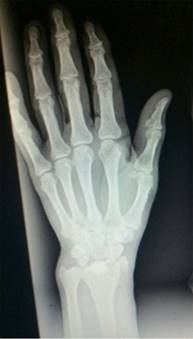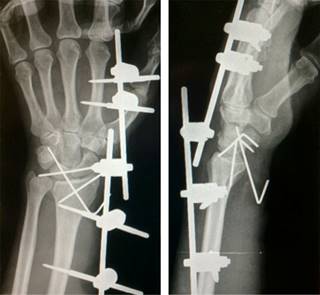Introduction
Acute semilunate and perilunate bone dislocation, although uncommon, is considered to provoke the most severe carpal distress and wrist instability.1,2,3
Associated directly with high-energy trauma, such as sport-related accidents, it may frequently occur among young adults and is mostly seen in patients who experienced falls with hyperextended wrists.1,2,4,5
An optimal clinical approach is the prevention of complications (necrosis, median nerve injury and chronic carpal instability) through the continuity of early treatment. A thorough clinical evaluation supported by imaging will ensure such prevention as well as a correct diagnosis.1,2,6,7
According to literature, 25% of these cases end either untreated or misdiagnosed.2
Main radiology findings include:1,8
Case presentation
After a motorcycle accident, a 50-year-old male patient is brought to the ER by the EMS.
Results of a first evaluation indicated deformity, swelling, neurovascular compromise, and a decreased wrist movement. The patient also referred severe pain.
X-ray results showed a radial styloid fracture and semilunate dislocation of the left wrist (Figure 1). In addition to these findings, a lateral condyle fracture of the left femur and a radial styloid fracture of the right wrist were also appreciated.
Treatment
The patient was taken to the OR in which under general anesthesia, three 6.5 mm cannulated screws were used to perform a closed reduction of the lateral condyle of the left femur. In addition, a percutaneous fixation of the left radial styloid and the right radial styloid were performed (Figure 2).

Figure 2: Intraoperative volar exposure of the wrist showing the lunate dislocated in the carpal tunnel.
The intention was to bring the bone through the carpal tunnel with the aid of the closed reduction of the lunate. After having proved unsuccessful, a Henry (Volar) approach was made. Later on and with the use of K-wire fixation, the lunate was reduced through the carpal tunnel, thus connecting the scaphoid with the semilunate and then the latter to the capitate.
Stability was verified with an intraoperative X-ray, once ligament reconstruction was performed (Figure 3).
Outcome and follow-up
Considerable improvement was obtained. Pain and swelling disappeared completely; nevertheless, limited motion range remained within the wrist.
Patient’s perspective
I’m a 50-year-old male who enjoys motorcycle driving. One day while riding on my bike, I had an accident after which I experienced severe pain in my limbs. I was driven to the ER at the nearest hospital and after careful examination and X-rays were taken, it was revealed that I had suffered three different fractures as well as a dislocation in my right wrist.
The pain was really unbearable and soon after the accident, my hands became very swollen, both factors made it almost impossible for me to move my hands as I normally do.
I grew increasingly worried because my job entails the complete use of both hands. I had to undergo a surgical procedure, and although the swelling and pain disappeared after several weeks, my worst fears became a reality as a limited motion range remained.
Discussion
While the patient waits for surgical intervention, closed reduction should immediately be attempted. Such measure will lower the necrosis risk and relieve pressure on the median nerve.2,9
Both the volar and dorsal approaches are normally chosen as a first approach and are done using K-wires to obtain internal fixation.2,3,7 The dorsal approach is essential in obtaining long-term successful results.2 These are assured with the repair of the scapholunate interosseous ligament, as well as the alignment of the carpus.2,3
Even so, there is a poor prognosis recorded for these injuries. Among other consequences, patients experience loss of strength and motion.1,2,3,6 Persistent carpal misalignment, open injuries, and delay in treatment, are key factors that promote a poor prognosis.1,2,3,7
Further complications such as residual carpal instability, complex regional pain syndrome, to name a few, are often associated to the original trauma.1,2,3,5,7
Learning points/take home messages
Semilunate dislocation is a frequently unrecognized injury that needs to be discarded especially in polytraumatized patients.
Closed reduction should be attempted promptly to avoid necrosis risk and relieve pressure on the median nerve.
This injury has been presented to have a very poor prognosis due to loss of strength and motion.











 nueva página del texto (beta)
nueva página del texto (beta)




